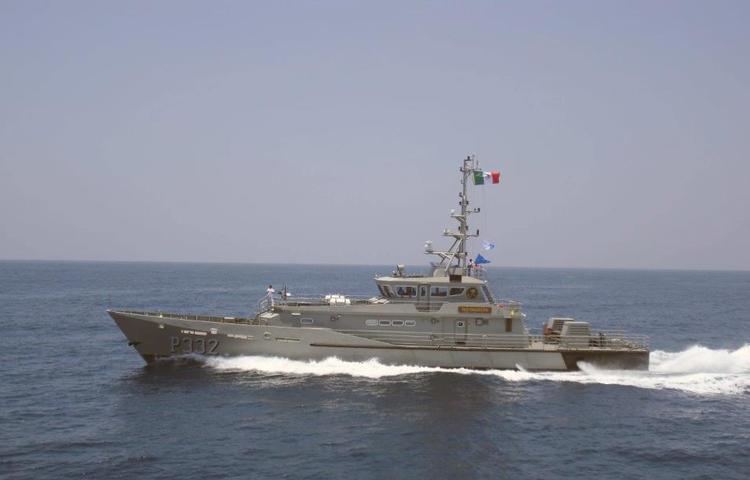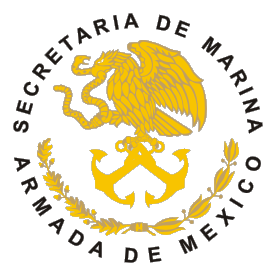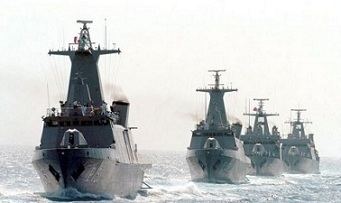Country Mexico Size 56,000 personnel | Type Navy | |
 | ||
Active January 19, 1821; 196 years ago (January 19, 1821) Part of Secretariat of The Navy Anniversaries June 1, National Navy Day Similar Mexican Army, Mexican Armed Forces, Mexican Air Force, Chilean Navy, Argentine Navy | ||
The Mexican Navy is one of the two independent Armed Forces of Mexico. The actual naval forces are called the Armada de México. The Secretaría de Marina (SEMAR) (English: Naval Secretariat) includes both the Armada itself and the attached ministerial and civil service. The commander of the Navy is the Secretary of the Navy, who is both a cabinet minister and a career naval officer.
Contents
- History
- Organization
- Naval Infantry
- Search and rescue units
- Maritime Role
- Training and education
- Modernization and budget
- Ships
- Shipbuilding
- Missiles
- Radar modernization
- Present fleet
- Aircraft inventory
- Future
- 2014
- References

The Mexican Navy's stated mission is "to use the naval force of the federation for external defense, and to help with internal order". The Navy consists of about 56,000 men and women plus reserves, over 189 ships, and about 130 aircraft. The Navy attempts to maintain a constant modernization program in order to upgrade its response capability.

Given Mexico's large area of water (3,149,920 km2) and extensive coastline (11,122 km), the Navy's duties are of great importance. Perhaps its most important on-going missions are the war on drugs and protecting PEMEX's oil wells in Campeche in the Gulf of Mexico. Another important task of the Mexican Navy is to help people in hurricane relief operations and other natural disasters.

Starting with the term of President Enrique Peña Nieto, the prefix ARM (Armada República Mexicana, Mexican Republic Navy) started being used in all naval vessels in active service.
History
The Mexican Navy has its origins in the creation of the Ministry of War in 1821. From that year until 1939 it existed jointly with the Army in the organic ministry. Since its declaration of independence from Spain in September 1810, through the mid decades of the 19th century, Mexico found itself in a constant state of war, mostly against Spain which had not recognized its independence. Therefore, its priority was to purchase its first fleet from the U.S. in order to displace the last remaining Spanish forces from its coasts.
The Mexican Navy has participated in many naval battles to protect and defend Mexico's interests. Some of the most important battles were:
The first French intervention in Mexico (The 'Pastry War') (November 1838 - March 1839)
Second invasion by the United States (April 9, 1914 – November 23, 1914)
Organization
The President of Mexico is commander in chief of all military forces. Day-to-day control of the Navy lies with the Navy Secretary, Vidal Francisco Soberón Sanz. In Mexico there is no joint forces command structure with the army, so the Secretary reports directly to the President. The Navy has a General Headquarters and three naval forces. There are furthermore 8 regions (4 on the Pacific coast, 3 on the Mexican Gulf coast and the Región Naval Central, grouping the naval forces, based in and around the capitol Mexico city, such as the 7th Naval Infantry Brigade, the Central Special Operations Group and the Air Transport Squadron), 13 zones, and 14 naval sectors.
The Navy is divided into three main services designated as "forces":
Other notable services include:
Officers are trained at the Mexican Naval Academy, called the "Heroica Escuela Naval Militar" ("Heroic Military Naval School"), located in Antón Lizardo, Veracruz.
Naval Infantry
The Mexican Naval Infantry Corps was reorganized in 2007-2009 into 30 Naval Infantry Battalions (Batallones de Infantería de Marina - BIM), a paratroop battalion, a battalion attached to the Presidential Guard Brigade, two Fast Reaction Forces with six battalions each, and three Special Forces groups. The Naval Infantry are responsible for port security, protection of the ten-kilometer coastal fringe, and patrolling major waterways.
The Naval Infantry also is responsible for 23 National Service Training Units under the responsibility of the Navy Secretary, enforcing the National Service obligation for Mexicans of teenage and young adult age.
Search and rescue units
In 2008, the Mexican Navy created its new search and rescue system, allocated in strategic ports at Pacific and Gulf of Mexico ports, to provide assistance to any ships which are in jeopardy or at risk due to mechanical failure, weather conditions or life risk to the crew. To provide such support, the Navy has ordered Coast Guard Defender class ships (2 per station, and one 47-Foot Motor Lifeboat coastal guard ships). Other stations will be provided only with Defender class boats.
Maritime Role
On April 1, 2014 SEMAR officially announced the creation of Port Protection Naval Units (Unidades Navales de Protección Portuaria: UNAPROP) which will include a marine section. The main task of UNAPROPs is to ensure Maritime surveillance and inspection.
Training and education
The Navy offers several options for graduate studies in their educational institutions:
It is the school where future officers are trained for the General Corps of the Navy. Candidates can enter upon completing high school. Upon completion of studies, graduates obtain the degree of Corbeta Lieutenant and the title of Naval Science Engineer.
This school Located in Mexico City, offers a career in medicine. Officers are trained with skills for the prevention and health care of naval personnel. By adopting a professional examination, graduates can obtain the degree of Naval Military Lieutenant Corvette.
In the Naval Engineering School, officers are responsible for the preventive and corrective maintenance of systems and electronic equipment installed on ships and installations of the Mexican Navy. This school offers career of Electronic Engineering and Naval Communications. It is located between the town of Mata Grape and Anton Lizardo, 32 km from the port of Veracruz.
Here the time to achieve a nursing degree lasts eight semesters. Officers are trained with the knowledge and skills necessary to enable them to assist medical personnel in caring for patients in hospitals, sanatoriums, clinics, health sections on land, aboard ships and at The Naval Medical Center.
The Naval Aviation School trains pilots for the Mexican Navy as well as staff from the Federal Preventive Police and Naval personnel from various countries of Central America. This school is located on Veracruz.
Located in Acapulco, members of The Navy are trained for marine search, rescue and diving. It also trains state police officers and firefighters.
Modernization and budget
The annual Navy's budget is in a 1 to 3 proportion of the national budget relative to the Army & Air Force. The Navy has a reputation for being well-run and well-organized. This reputation allows for a close relationship with the U.S. Navy, as evidenced by the procurement of numerous former USN ships.
Ships
The Secretary of the Navy, Admiral Francisco Saynez Mendoza, announced on October 1, 2007, detailed plans to upgrade and modernize the country's naval capabilities. On the following day, La Jornada newspaper from Mexico City, disclosed the Mexican Navy plans, which are among others, to build six oceanic patrol vessels (OPV) with a length of 86 meters, 1680 tons and each housing a Eurocopter Panther helicopter as well as small high speed interception boats. The budget for this project is above $200 million USD.
Another project is to build 12 CB 90 HMN high speed (50 knots) interception boats under license from a Swedish boat company to the Mexican Navy. Also, a number of fully equipped planes for surveillance and maritime patrol are being considered. Combinations of options and development are being defined.
Shipbuilding
The Mexican Navy depends upon their naval shipyards for construction and repairs of their ships. There are 5 shipyards located in the Gulf of Mexico and Pacific Ocean:
Missiles
The Mexican Navy initiated studies to develop and construct its first missile, according to a May 2005 interview with the undersecretary of the Navy, Armando Sanchez, the missile was to have an average range of 12 to 15 kilometers and be able to target enemy ships and aircraft. The undersecretary added that they already had the solid propellant, and the basic design of the missile. All aspects relative to their fuselage were solved as well as the launch platforms. The Mexican Navy was developing the software to direct the missile to its target. In July 2008, the project was reported to be 80% complete. Despite this effort, the missile development was canceled in 2009 due to "problems with the propulsion system".
Radar modernization
In 2009, the Mexican Navy began operating a batch of new MPQ-64 Sentinel radars in the oil-rich Gulf of Mexico. The radar network was installed in 2007 for a trial phase while military personnel were trained to get familiar with the system. The new installations will work together with combat surface vessels that patrol the area.
Present fleet
The Mexican Navy includes 60 smaller patrol boats and 32 auxiliary ships. It acquired 40 fast military assault crafts, designated CB 90 HMN, between 1999 and 2001 and obtained a production license in 2002 enabling further units to be manufactured in Mexico.
Aircraft inventory
The aircraft quantities are approximate, and estimated to be 68 airplanes and 54 helicopters.
Future
For the year 2008 budget, the Mexican Congress approved a $15 million USD funds to build only 17 out of 60 combat boats requested. These ships, designated CB 90 HMN, are to increase its fast boat fleet. Additional budgets will be awarded each passing year. In total, the Mexican Navy has over 189 operational ships.
In January 2013, the 112th Session of US Congress authorized the transfer of the Oliver Hazard Perry-class frigates USS Curts and USS McClusky to the Mexican Navy, but due to the cost of overhauling the vessels and the removal of all the weapons systems and most of the electronics and radar gear by the US Navy prior to transfer, this is still undecided by Mexico. The offer expired on 1 January 2016.
2014
On March 25, 2014 Beechcraft Corporation received an order of 2 T-6C+ military trainers from the Mexican Navy.
On June 24, 2014 the Mexican Government requested the purchase of 5 UH-60Ms in USG configuration from the U.S.; its estimated cost is $225 million. Also on June 24, BAE Systems announced it was awarded a contract by the Mexican Government to supply the navy with 4 Mk 3 57mm naval guns, for which ship is to be armed with Mk 3s is still unknown.
